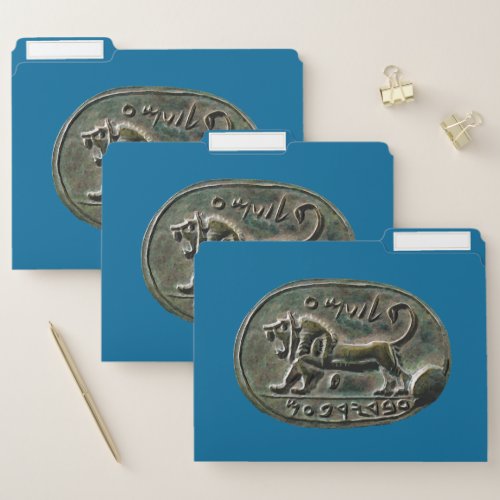Megiddo Seal File Folder



Features a digital rendition of the Megiddo Seal; also known as the Seal of Jeroboam or Shema Seal. You may change the background color, inside and out. The seal was discovered in 1904 during archaeological excavations conducted by Gottlieb Schumacher at Megiddo in what is now northern Israel during the Turkish occupation of the land. It was discovered accidentally in the excavation dump, not in a stratified level. The seal, carved in jasper, was lost en route to the Istanbul Museum, though an impression cast in bronze was made prior to its shipment. It is engraved with the figure of a roaring lion (symbol of the kingdom of Judah) with a beautiful curved tail with beautiful workmanship. The Hebrew inscription on it reads "Shema" on top, and "Servant of Jeroboam" on the bottom. "Shema servant of Yarob'oam" Most biblical scholars accept that this refers to king Jeroboam II and that the seal belonged to a royal minister in the 8th century BC. The inscription actually proclaims the name and rank of its owner, one of the ministers of King Jeroboam II who reigned from 787-747 BC. The word "servant" is the Hebrew word "ebed" and is mentioned in the Bible as one of high dignity in the government. Many seals have been discovered with similar inscriptions like "the servant of the king." The Megiddo Seal with the Jeroboam Inscription is of great importance in Biblical Archaeology, it mentions one of the kings of the northern kingdom of Israel. 2 Kings 14:23-25 In the fifteenth year of Amaziah the son of Joash, king of Judah, Jeroboam the son of Joash, king of Israel, became king in Samaria, and reigned forty-one years. And he did evil in the sight of the LORD; he did not depart from all the sins of Jeroboam the son of Nebat, who had made Israel sin. It is very interesting that the Jasper Seal of Megiddo would contain the symbol for the Southern Kingdom of Judah. But in examining all of the circumstances involved and seeing what the Bible says it is no wonder that the prosperous and victorious Northern Kingdom of Israel would boast with a symbol of their rival. Lets go back just a few verses and see what happened just before Jeroboam II became king: 2 Kings 14:12-14 And Judah was defeated by Israel, and every man fled to his tent. Then Jehoash king of Israel captured Amaziah king of Judah, the son of Jehoash, the son of Ahaziah, at Beth Shemesh; and he went to Jerusalem, and broke down the wall of Jerusalem from the Gate of Ephraim to the Corner Gate--four hundred cubits. And he took all the gold and silver, all the articles that were found in the house of the LORD and in the treasuries of the king's house, and hostages, and returned to Samaria. Jeroboam has been acknowledged as a powerful ruler who put into effect building projects throughout the land. The archaeologist, professor Yadin, has said of the buildings uncovered at Hazor and attributed to Jeroboam, that they are `among the finest of the entire Israelite period.’ But the biblical record also tells us that he took back a lot of territory lost to previous invaders. We read: “He was the one who restored the boundaries of Israel from Lebo Hamath (northern Syria) to the Sea of the Arabah,…(Dead Sea)” 2 Kings 14:25 Jeroboam II inaugurated the longest reign of a king of Northern Israel in 788 BCE. He ruled over a period of unparalleled prosperity, taking advantage of a lapse in strong Assyrian control of the Levant. Jeroboam’s name is preserved on a seal made of jasper that is dated paleographically to the mid-eighth century, ruling out Jeroboam I, a tenth-century king of Israel. The seal depicts a magnificent lion, realistically shown in full-throated roar with its tufted tail erect. Several other seals from the late Iron Age bear the title ‘bd hmlk, “servant of the king,” an indication that the ‘ebed was a high-ranking official of the kings of Israel and Judah. Biblical evidence lends further credence to this hypothesis. For example, one of the royal officials listed in 2 Kings 22:12 is “the king’s servant (‘ebed hammelek) Asaiah” (see also 1 Kings 1:47; 2 Kings 5:6, 25:8).


